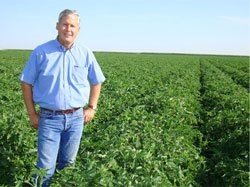By Ian James
Don Cameron expects farmers will see some of the biggest effects as the climate changes, and he says growers need to take proactive steps to prepare.
For 35 years, he has been the vice president and general manager of Terranova Ranch near Fresno, and he has noticed rising temperatures are starting to push up the times of plantings near the end of the winter. He expects that in the future, climate change will mean less reliable water supplies for farms in California and elsewhere.
Cameron, who is also a board member of the California State Board of Food and Agriculture, manages more than 7,000 acres of farmland growing a variety of crops from tomatoes and peppers to wine grapes and almonds. He is one of several featured speakers at the upcoming One Nation: Climate Change forum at the Sunnylands Center and Gardens in Rancho Mirage.
The April 20 event, hosted by The Desert Sun and the USA TODAY NETWORK, will bring together scientists, policymakers, artists and others to discuss climate change and what can be done to address it. Other speakers will include Steve Beissinger, a professor of conservation biology at the University of California, Berkeley; Kelly Sanders, a water and energy expert from the University of Southern California; and Jeff Grubbe, chairman of the Agua Caliente Band of Cahuilla Indians.
To set the stage for the event, The Desert Sun posed several questions to Cameron by email about climate change and what he thinks can be done to prepare for the impacts on agriculture.
Q: In your experience managing a farm in the Central Valley, how is the warming climate starting to affect agriculture? And in what ways do you think climate change will impact the country’s farms in the future?
A: In managing a farm in Fresno County, one of the most productive agricultural areas in the world, I have seen firsthand the effects of climate change. In 2015, the chilling hours needed for dormancy for pistachios was lacking. In other words, the winter was too warm for the trees to adequately rest during the winter, which disrupted pollination of the trees. The result was that yields were off 35-40% from expected yield. We have also taken advantage of longer, warmer weather in the fall by planting peppers that are not harvested until late October and early November – something unheard of before.
Q:What do you think are the most important steps that should be taken to prepare for the effects of climate change on agriculture?
A: As farmers, we need to be aware of the changes and shift our selections to varieties that are more tolerant to warmer temperatures. There is a wide genetic variety within species and new varieties within crops each year. We need to be looking for varieties that perform well in warmer climates. The selection of crops may have to change as well.
Q: What have you done on your farm to try to prepare for the additional strains that climate change will place on water supplies?
A: In 2011 we initiated a trial for “on-farm recharge” to capture floodwater and place it on actively farmed land with the intent of recharging our underground aquifer. We followed up on the successful trial and now are engaged in a project that when complete will bring up to 1,000 acre-feet of floodwater per day to farmland for recharge of the aquifer. We know that we will see more flood and drought and less snowpack in future years, and that will make our project key to replenishment of groundwater in our basin.
Q: Farms are major water users, and in many areas of the country overpumping of groundwater has led to declining aquifers. What sorts of changes in farming practices or policies do you think hold the greatest potential for helping make agriculture more sustainable in the long run?
A: When we talk about the overpumping of groundwater in California, in 2014 the state legislature passed the Sustainable Groundwater Management Act. What SGMA does is to require local agencies to formulate long-term plans that will be monitored by the California Department of Water Resources to ensure sustainability of their underground water supplies. Simply put, farmers will not be able to pump more water out of an aquifer than can be replaced by either natural recharge or some sort of direct recharge. Replacement of underground pumping with surface water also is possible if surface water is available. However, new sources of surface water are extremely difficult at best to find and have been extremely expensive.



